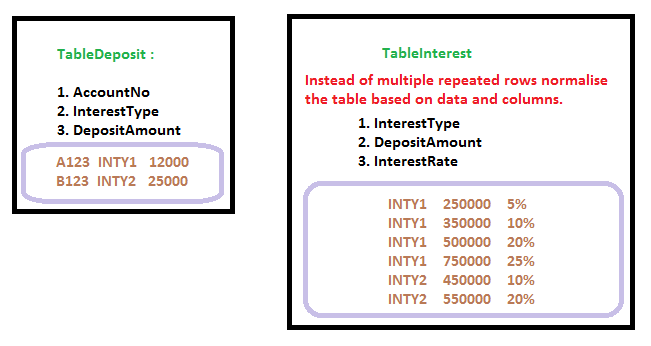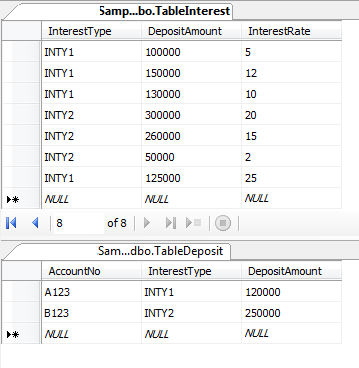emi_sastra
asked on
QUERY TABLE INTEREST
Hi All,
I have 2 tables :
TableDeposit :
1. AccountNo
2. InterestType
3. DepositAmount
TableInterest :
1. InterestType
2. DepositAmount1
3. InterestRate1
4. DepositAmount2
5. InterestRate2
6. DepositAmount3
7. InterestRate3
8. DepositAmount4
9. InterestRate4
10. InterestRate5
The DepositAmount at TableInterest is the limit of Deposit Amount for a certain Interest Rate.
How do I get the right Interest Rate from TableInterest by joining those tables ?
Thank you.
I have 2 tables :
TableDeposit :
1. AccountNo
2. InterestType
3. DepositAmount
TableInterest :
1. InterestType
2. DepositAmount1
3. InterestRate1
4. DepositAmount2
5. InterestRate2
6. DepositAmount3
7. InterestRate3
8. DepositAmount4
9. InterestRate4
10. InterestRate5
The DepositAmount at TableInterest is the limit of Deposit Amount for a certain Interest Rate.
How do I get the right Interest Rate from TableInterest by joining those tables ?
Thank you.
ASKER CERTIFIED SOLUTION
membership
This solution is only available to members.
To access this solution, you must be a member of Experts Exchange.
No problem - let me know if it doesn't work as you want
ASKER
Sure, thank you.
Structure is defined in the image might help you in easy way.

 And output is based on interest type.
And output is based on interest type.

DECLARE @INTERESTTYPE CHAR(10)
SET @INTERESTTYPE = 'INTY2';
WITH LASTVISIT ( DEPOSITAMOUNT, INTERESTRATE )
AS
(
SELECT DEPOSITAMOUNT,
INTERESTRATE
FROM TABLEINTEREST
WHERE INTERESTTYPE = @INTERESTTYPE
)
SELECT TOP 1
LV.INTERESTRATE
FROM TABLEDEPOSIT TD
INNER
JOIN LASTVISIT LV
ON TD.DEPOSITAMOUNT < LV.DEPOSITAMOUNT
ORDER
BY LV.DEPOSITAMOUNT;
GOASKER
That's great.
I know the interest table is not normalized.
Since the structure is like that in dbf and I want to transfer to sql with the structure you suggest.
How could I do it ?
Should I open a new question for this ?
Thank you.
I know the interest table is not normalized.
Since the structure is like that in dbf and I want to transfer to sql with the structure you suggest.
How could I do it ?
Should I open a new question for this ?
Thank you.
I think so, you should really try to normalise the table as anuradhay suggests but that is really a different question.
Cheers
John
Cheers
John
ASKER
Let me open a new question.
Thank you.
Thank you.
ASKER
Done.
ASKER
I've not tried it, but I think it should work.
Thank you very much for your help.